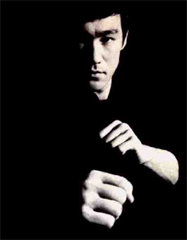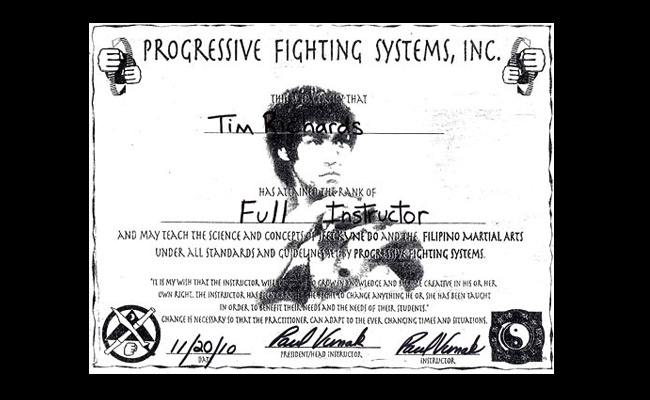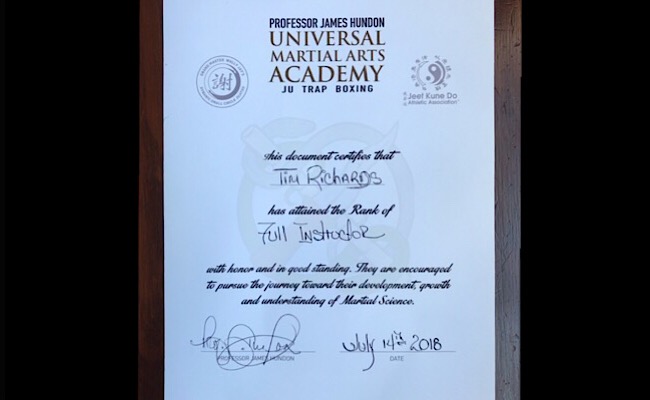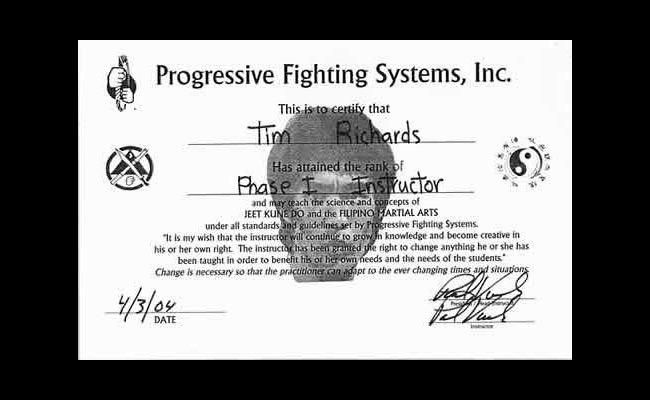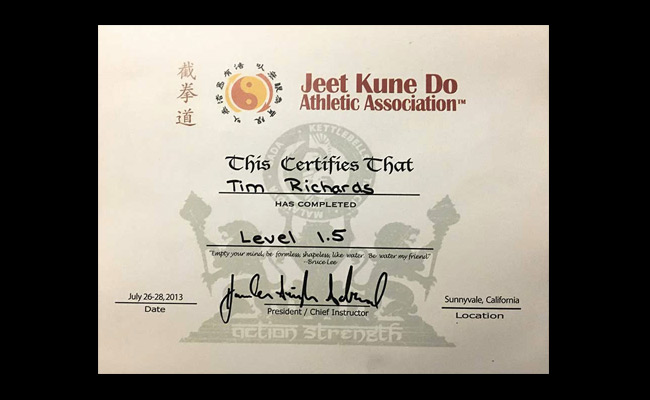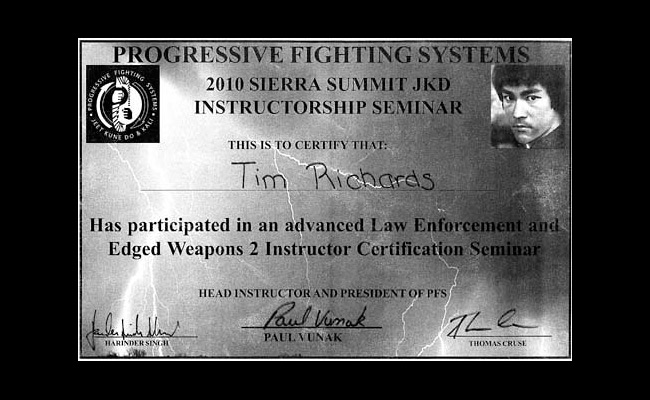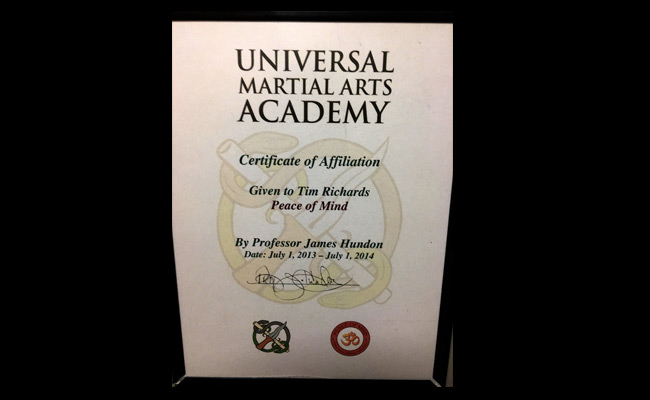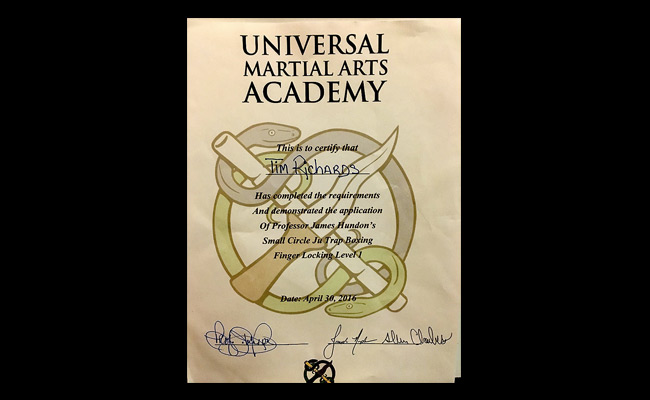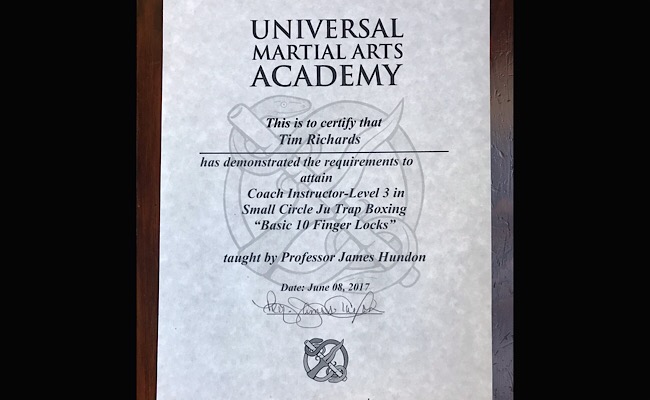"Jeet Kune Do is training and discipline towards the ultimate reality in combat.
Jeet Kune Do is the only non-classical style of Chinese Kung Fu in existence today. It is simple in its execution, although not so simple to explain.
Jeet means 'to stop, to stem, to intercept,' while Kune means 'fist' or 'style,' and Do means 'the way' or 'the ultimate reality.' In other words--'The Way of the Intercepting Fist.'"
--Sijo Bruce Lee
Jeet Kune Do is the name Bruce Lee gave to his own personal theories and principles on street fighting and self defense. This method of training will teach you how to function out of all 4 ranges of combat - Kicking, Punching, Trapping, and Grappling. My goal is to help you develop the confidence and ability to adapt to any opponent, range, or situation.
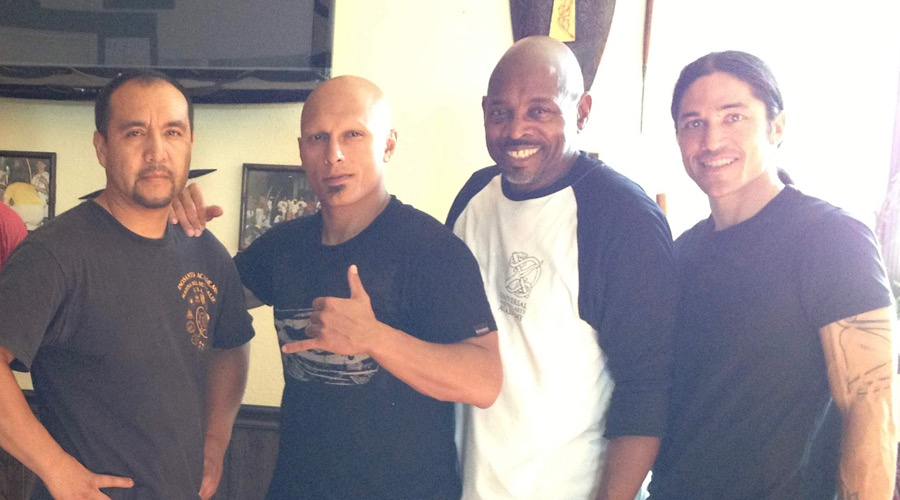
This is accomplished by providing you with a blend of various training modalities designed to increase your attribute level and fighting skill. This is not a random mixture of martial arts but rather a series of proven training methods developed by Sijo Bruce Lee, Guru Dan Inosanto, Sifu Paul Vunak, Sifu Harinder Singh Sabharwal and Grand Master James Hundon ("The Professor").
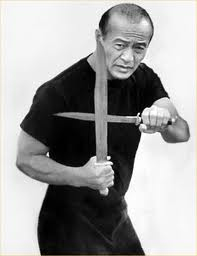
The training you will receive is the essential foundation needed to properly blend all the ranges together and become a fully functional fighter allowing you to defend yourself and your family. Sifu Tim Richards has over 20 years experience in JKD and has been certified by world renowned martial arts instructors Paul Vunak, Harinder Singh Sabharwal, and James Hundon to teach Bruce Lee's art and philosophy.
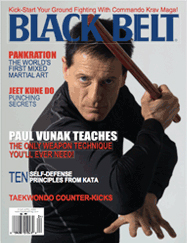
Tim Richards received his first certification to instruct Jeet Kune Do from Paul Vunak, founder of Progressive Fighting Systems, in 2004. Progressive Fighting Systems (PFS) is an organization dedicated to teaching realistic self defense and promoting the expansion of Jeet Kune Do and the Filipino Martial Arts.
Paul Vunak is the developer of the R.A.T. system and a combat trainer of Navy SEAL teams, FBI and DEA agents. Paul is a top student of Dan Inosanto who was, in turn, a top student of Bruce Lee. Dan is considered to be one of the co-founders of JKD and has continued to develop the art since Bruce Lee's death.
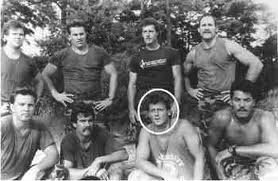
Rapid Assault Tactics was developed for U.S. Navy SEAL Team 6 as a primary combative program based in Jeet Kune Do concepts. The R.A.T. system places an emphasis on self-preservation using a realistic fighting structure that is designed to neutralize a bigger and stronger opponent.
Rapid Assault Tactics focuses on identifying the phase or range in which an attack situation is occurring and teaches you how to respond to the threat with the appropriate tools. These tools and techniques are comprised of simple and efficient responses that can be relied on during the "fog" of battle.
A special quality of the PFS system is the development of emotional control while working in high stress, reality-based conditions. Today, the R.A.T. system is taught to Special Forces, Military, FBI, DEA, CIA, U.S. Secret Service, SWAT, and over 50 police Departments in the U.S. and other countries.
The complete Progressive Fighting Systems curriculum includes force continuum, weapons, stand up, mass attack, and ground fighting tactics.
Training is personally taught by Tim Richards who is a Full Instructor, and LEO / Edged Weapons Instructor under Sifu Paul Vunak.

In 2013 Tim received his certification to teach Small Circle Ju Trap Boxing, and became the first affiliate school of Universal Martial Arts Academy. Dynamic Small Circle Ju Trap Boxing was developed by Grand Master James Hundon as a synthesis of his extensive experience in the martial arts, the security industry, and training law enforcement professionals.

Ju Trap Boxing stays true to its root of Small Circle Jujitsu, and Sanuces Ryu Jujitsu while incorporating fundamentals of boxing, Jeet Kune Do and Filipino martial arts into a comprehensive, practical approach to self-defense. It teaches us to be comfortable defending ourselves in all fighting ranges - using strikes and traps to nullify the attack, and finishing with jujitsu when in close contact.
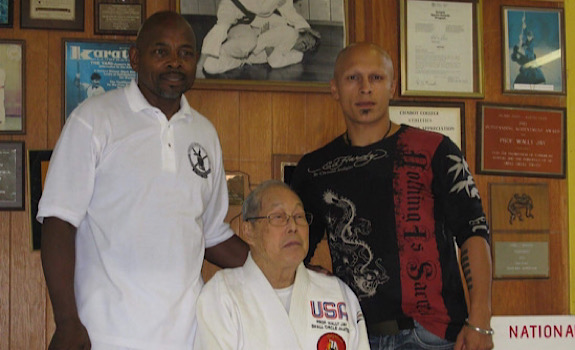
An emphasis is placed on understanding locking entries while moving and transitioning. Techniques are taught as drills that enhance muscle memory, timing, and ease of use.
Ju Trap Boxing also teaches us philosophical principles that apply to our everyday lives as much as to self defense situations. How do we learn to adapt to sudden changes? How do we take control of situations? How do we focus on the positive and discard the negative?
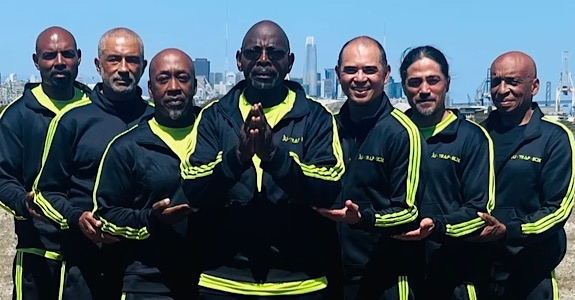
The ultimate focus of Ju Trap Boxing is to blend, adapt and become one with the challenges we are faced with in life - whether physical, mental or spiritual. In this journey towards spiritual balance we also find our own personal self-expression.

Filipino Martial Arts (Kali & Serrada Escrima) are extremely effective, battle tested, weapons based systems. The bulk of your training in these arts will be with weapons such as the stick, knife, sword and staff. I also teach various empty hand systems that are taken from these dynamic and functional arts that will more than compliment your JKD concepts training.
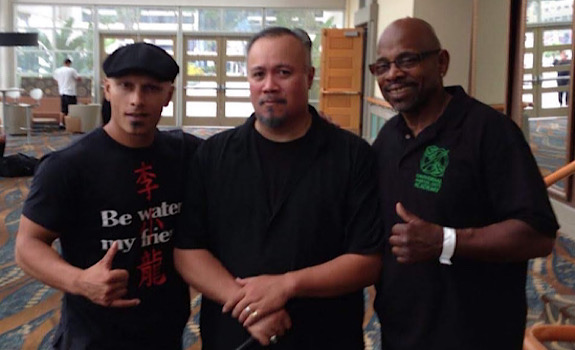
The training methods of the Filipino Martial Arts will increase your empty hand skills by supercharging such attributes as coordination, perception, awareness, and timing. One of the main goals of training in these systems is the ability it will give you to pick up everyday objects and use them to your advantage.
Your car keys, umbrella, the chair your sitting on, the belt or jacket you are wearing, all of these are weapons in the hand of a skilled Filipino Martial Arts practitioner. There is no substitute for the confidence that comes from knowing you can handle what ever may happen.
Other areas studied in the Filipino Martial Arts include:
- Single Stick
- Double Stick
- Single Knife
- Double Knife
- Stick and Knife
- Staff/SpearAxe
- Thrown Weapons (Darts/Knives/etc.)
- Dumog (Grappling)
- Panantuken (Filipino Boxing)
- Pananjakman (Kicking Art)
- Kina Mutai
- Silat
Attributes are the inner qualities that shape technique; that provide the ground from which technique springs, and are the primary focus of Jeet Kune Do training.
- Awareness To see the opponent's intentions.
- Line Familiarization To be familiar with the angle of attack that an opponent launches.
- Sensitivity To feel the opponent's intentions.
- Proper Mental Attitude Combination of calm, killer instinct, and confidence.
- Body Mechanics Knowing how and where to position the body at all times; using no wasted motion.
- Strength Ability to overwhelm an opponent through manipulation.
- Footwork Putting oneself where one needs to be at all times by shuffling forward and back, sidestepping and circling.
- Speed Perception of initiation and performance of an action.
- Power Combination of strength and speed (ability to use your strength quickly).
- Timing Ability to launch an attack at the proper moment.
- Coordination Performing a movement with efficiency, ease and balance.
- Balance Correct body alignment during motion (controlling one's center of gravity).
- Spatial Relationships Control over distance (range).
- Agility Being light on one's feet with limberness and quickness.
- Stamina Combined endurance and wind.
- Conditioning Taking punishment to hands, stomach, thighs and shins.
- Rhythm Deals with faking, cadence breaks, changing tempos, etc.
- Precision Accuracy and exactness in the projection of force.
- Explosiveness Relaying destructiveness in a sudden manner.
- Flow Combination of awareness and sensitivity; uninterrupted concentration.
--Sifu Paul Vunak
Jeet Kune Do approaches effective self defense in a uniquely different manner which sets it apart from most other Martial Arts. Some distinctive principles are noted with a brief description.
Non Telegraphic Movement - Drawing the arm back before striking, stepping before kicking or showing any obvious "build up" movement tells the opponent what you're about to do. This gives them the opportunity to counter attack you. We learn to punch and kick efficiently without telegraphing our intentions.
Strong Side Forward - We stress the use of our strongest and most coordinated weapons (Hand and Foot) out front, where they can do the most damage. If you are right handed, you will be in a right lead fighting stance. If you are left handed, it's a left lead fighting stance.
This in turn makes the weaker weapons stronger, giving you two strong sides to use for attack. We use the lead hand for 80% offense, 20% defense. The rear hand is mostly used as a defensive tool, 80% defense, 20% offense.
Longest Weapon To The Closest Target - When attacking from a distance to the nearest target, JKD uses the lead hand for punching and the lead leg for kicking. The rear tools are further away, take longer to get to the target and can be countered more easily.
Non Classical Movement - We do not employ the use of set or fixed training forms or patterns. They do not accurately represent realistic fight situations. We employ drills that keep the relationship between the opponents alive, fluid and mobile.
Use Of Broken Rhythm - Used while attacking or counter attacking, it allows you to catch your opponent while they are motion set, thus making it harder for them to defend or counter your attack.
In attacking, there are a few ways to break the rhythm within a series of movements after a rhythm has already been established. For example, speed up suddenly, slow down suddenly, and/or insert a brief pause or delay in the series of movements.
In counter attacking, you can hit on the half-beat to break an opponent's rhythm and interrupt their attack. If you hit the opponent before he completes the first strike, you've hit on the half-beat.
If you parry the first strike, and hit between the first and second strikes, you have broken the rhythm on the one and a half-beat. Control the rhythm, you can control the fight.
Adaptability - Fights are abstract and are constantly changing. One must be able to adapt to these changing situations. You cannot be bound by fixed techniques, a single system or method. You must be free to use whatever works and to express yourself without limitations.
Use Of Feints and False Attacks - Feints are actions that make an opponent think an attack is being launched against them. The object is to divert their attention from your final or intended point of attack.
False attacks are intentionally made to fall short of a target and to draw a defensive reaction from the opponent. This will help you discover how they will react to your movements and is a set up for other types of attacks, such as Attack by Combination and Progressive Indirect Attack.
Interception - The words Jeet Kune Do translate to "Way of The Intercepting Fist." It is least efficient to block first, then hit. It's more efficient to simultaneously parry and hit, or even better, intercept the attack.
This is best accomplished by controlling the distance so your opponent has to move towards you to get to you. The mind-set of defend and hit must be changed to "think hit."
Centerline - Looping or grand movements are very telegraphic and easy to defend or intercept. Strikes going down the centerline are difficult to see and defend against.
There are some major targets located along the centerline such as the eyes, nose, chin, throat, solar plexus and groin. In controlling the centerline, you also can control the balance, position and leverage of an opponent and their ability to attack you.
Alive Footwork - Good mobility is essential. It can put you in a position to hit, or it can take you out of position from being hit. Distance, rhythm and timing are controlled with footwork, which should always be alive, fluid and mobile.
Focus on Low Line Kicking - Kicking high to head in street fights can be dangerous. High kicks are slower, easier to defend, more telegraphic and you need to be very limber to execute them.
Low line kicks to the groin, knee and shin are quite effective and much safer to execute. They are also faster, harder to defend, less telegraphic and your balance is not as compromised.
The Five Ways of Attack - Even though there are many Martial Arts systems, styles and methods, there are basically only five ways for you to attack or be attacked. In JKD we classify them as:
Single Direct Attack/Single Angulated Attack - SDA is a single motion (Punch or Kick) which moves with no effort to conceal it, directly to the target on the most economical route. It can also be indirect, beginning on one line and ending on another.
Such as a punch that starts to the stomach (mid line) and ends on the chin (high line). SAA is an attack that is launched from an unanticipated angle that is achieved by moving in such a way as to create an open line into which to strike.
Attack by Combination - An offensive attack made up of two or more movements in a natural progression that lands on single or multiple targets. Attack combinations can be comprised of hand to hand, hand to foot, foot to hand and foot to foot strikes.
Attack by Draw - The goal when using attack by draw is to "draw" the opponent into a committed attack by baiting them into what looks like an exposed target, then intercepting his/her motion. Or you can execute a motion that invites a counter, then counter attack them as they take your bait.
Progressive Indirect Attack - Taken from Western Fencing originally, the idea of "second intention" is employed here where you use an initial false attack or feint to draw some type of defensive reaction from your opponent. After you get the attempted block or parry you deceive that defensive motion by quickly shifting lines and hitting to an open target.
Progressive means you will cover at least half the distance between you and your opponent by moving forward on the initial false attack or feint. Indirect means to gain time by putting your opponent a half beat behind your motions.
You don't wait for their block to land, you shift lines just as it's moving towards your initial strike. This timing is used to take advantage of the best "window of opportunity" to deceive the opponent.
Hand Immobilization Attack - Taken originally from Wing Chun and later modified, "trapping" is an effective tool against systems that block first, then hit. This is an attack that will momentarily immobilize or "trap" one or both of the opponent's arms, allowing you to strike into an open line. You can also purposely draw a reaction from them to be countered with a trap.
- Bai Jong - Ready Position
- Biu Gee - Thrusting Fingers
- Biu Sao - Thrusting Hand
- Bong Sao - Deflecting Hand (Raised Elbow)
- Bo Pai - Double Palm Strike
- Chi - Has a Few Definitions such as "Energy", "Spirit" or "Breath".
- Chi Gerk - Sticky Legs
- Chi Sao - Energy Hands also called Sticky Hands
- Chop Choi - Extended Knuckle Punch
- Chum Kiu - 2nd Form of Wing Chun Kung Fu (Seeking the Bridge)
- Chung Choi - Vertical Fist
- Cup Sao - Scooping Hand
- Da - Hit or Strike
- Do - a.k.a. "Tao" Meaning "Way"
- Doan Chi Sao - One Hand Energy Hands Training
- Dum Tek - Stomp Kick
- Fak Sao - Whisking Arm, Sideways
- Fon Sao - Trapping Hands
- Fook Sao - Horizontal Deflecting Hand (Bridging Hand or Bridge-On Arm)
- Gerk - Foot or Leg
- Gin Lai - Salute
- Gnoy Pak - Outside Pak Sao
- Go Da - High Hit
- Gon Sao - A Low Outer Wrist Block/Parry
- Gua Choi - Back Fist
- Gua Tek - Inverted Hook Kick
- Gum Sao - Pinning Hand, Downward Palm Block or Strike with Elbow turned Outward
- Ha Da - Low Hit
- Ha So Tek - Inverted Sweep Kick
- Ha Pak - Low Slap
- Hay - Begin
- Hok Sao - Crane Hand or a High Outside Block with Uplifted Wrist and Fingers Pointing Down
- Hou Juk Tek - Back Side Kick
- Hou Tek - Back Kick
- Huen Sao - Circling Hand
- Jang - Elbow
- Jao Sao - Running Hand
- Jeet - Stop or Intercept
- Jeet Gurk - Shin Block
- Jeet Kune Do - Way Of The Intercepting Fist
- Jeet Sao - Intercepting Hand, as used in the Shoulder or Bicep Stop
- Jeet Tek - Intercepting Kick
- Jern - Vertical Palm Strike
- Jik Chung Choi - Commonly Known as the Straight Blast Meaning Straight Vertical Fist. Used For Overwhelming an Opponent With Vertical Fists Down His Center to Find the Opening Using Forward Energy
- Jik Tek - Straight Kick or Front Kick With Toe
- Jin Choi - Uppercut
- Joap Hop - Line Up or Group Together
- Jong Sao - Dummy Hand, Inward Block Chop/Parry, Centerline Block or Strike
- Juen So Tek - Spinning Heel Kick
- Juen Tek - Spin Kick
- Juk Tek - Side Kick
- Jum Sao - Sinking Elbow Block/Parry contacting the Little Finger Side of the Forearm
- Jung Da - Middle Hit
- Jung Seen - Centerline
- Jut Sao - Jerking Hand
- Kau Sao - Circling Block
- Kow Tao - Head Butt
- Kune (Kun) - Fist
- Kwan Sao - A Bong & Tan Combination Movement; also used for Block with Outer Edge of Wrist, Palm Up; Similar to Tan Sao but goes in Opposite Direction to Close Off Center.
- Kwoon - School
- Lan Sau - Bar Arm
- Lao Sing Choi - Lateral Hammer Fist Strike or a Chop With a Closed Fist
- Lee Jun Fan - Bruce Lee's Chinese Name
- Lie Sao - Palm Up Pulling Deflection using the Edge of the Thumb/Wrist area (sometimes confused with Tan Sao, though they do look similar) to Redirect the Force of a Linear Strike always done from the Outside Line.
- Lin Dum Tek - Cross Stomp Kick (Oblique Kick)
- Lin Lop - Cross Grab
- Lin Sil Da - Simultaneously Defend and Hit (Lin Sil Die Dar)
- Lok Sao - Rolling Hands
- Lop Sao - Pulling Hand
- Loy Pak - Inside Pak Sao
- Maun Choi - Jab (Lead Punch)
- Maun Sao - Front Hand, Inquisitive Hand or Asking Hand
- Mook Jong - Wing Chung Dummy
- Na - Locking or Submission
- O'ou Choi - Hook Punch
- O'ou Tek - (Sometimes spelled "Now Tek" due to the sound of the word with an almost silent "N") - Hook Kick (commonly known as a Round House Kick in Other Martial Art Styles) Bruce Lee referred to the Round Kicks as Hook Kicks
- Pak Sao - Slapping Hand
- Ping Choi - Horizontal Fist
- Saat Da - Knee Strike
- Seong Chi Sao - Double-arm sticking hands
- Si Bak - Your Instructor's Senior
- Si Dai - Your Junior
- Si Fu - Teacher or Instructor
- Si Gung - Your Instructor's Instructor
- Si Hing - Your Senior
- Si Jo - Founder Of The System
- Sil Lim Tao - First Wing Chun Form Called "The Little Idea"
- Si Mo - Wife of Your Instructor or Female Instructor
- Si Sook - Your Instructor's Junior
- So Tek - Heel Kick
- Sut Sao - Slicing Hand or commonly known as to Chop
- Tan Sao - Palm Up Deflecting Hand
- Tek - Kick
- Tok Sao - Lifting Arm or Lifting Hand (Lifting Under the Elbow(s)
- Toi Ma - Retracting Stance, to Recover or Retreat
- Toi Sao - Retracting Hand
- Tow Dai - Student
- Tow Suen - Student's Student
- Wong Pak - Outside Cross Slap
- Wu Choi - Cross (as in Jab, Cross)
- Wu Sao - Rear Hand or Protective Hand
- Wu Tek - Rear Leg Kick
- Yang - Male, Positive, True, Hard, etc.
- Yee Gee Kim Yeung Ma - Character Two Stance, Goat Stance, Basic Wing Chun Stance.
- Yin - Female, Negative, False, Soft, etc.
- Yim Wing Chun - [Yim (a family name) / chant / springtime] - a student of Ng Mòi and the girl for whom this system is named.
- Yip Man - Yip (a family name) / continue / asking - born in 1898 in Fat Shan, died in 1972 in Hong Kong. He brought the Wing Chun system to Hong Kong, where he taught it to the public, He was Bruce lee's first formal teacher in the martial arts.
- Yu Bay - Ready
Please make direct contact to schedule an orientation.
cell 415-608-3723 or email sifutimr@gmail.com
Discounts offered to Military, Public Service Professionals.
Trades welcomed and further purchase discounts available.
Workshops available for Corporations and Startups.
PEACE, LOVE & THANK YOU

